| Pages:
1
2
3
4
5 |
aga
Forum Drunkard
    
Posts: 7030
Registered: 25-3-2014
Member Is Offline
|
|
So if i carefully neutralise the acid with NaOH and then chuck in some freshly scraped Mg, if it reacts (displacement), then it was CaCO3 ?
Edit:
Doh !
Other way round, and i have no Ca metal ...
[Edited on 29-7-2015 by aga]
|
|
|
blogfast25
International Hazard
    
Posts: 10562
Registered: 3-2-2008
Location: Neverland
Member Is Offline
Mood: No Mood
|
|
Mg and Ca are both electropositive elements and cannot be displaced from water. So that doesn't work at all.
Hint for a Ca<sup>2+</sup> test: CaSO4 is basically insoluble. MgSO4 is highly soluble.
[Edited on 30-7-2015 by blogfast25]
|
|
|
diddi
National Hazard
   
Posts: 723
Registered: 23-9-2014
Location: Victoria, Australia
Member Is Offline
Mood: Fluorescent
|
|
you have been busy aga. might have to get involved in a bit of molestation myself, so to speak
Beginning construction of periodic table display
|
|
|
aga
Forum Drunkard
    
Posts: 7030
Registered: 25-3-2014
Member Is Offline
|
|
Add Ca metal to water ? Tsk Tsk Tsk.
Note to self: do not post really dumb things after midnight.
So if i add MgSO4 solution and get a precipitate, then the original material was CaCO3.
Thanks !
Edit:
Found this useful list of some rock compositions :
http://www.physicalgeography.net/fundamentals/10d.html
[Edited on 30-7-2015 by aga]
|
|
|
diddi
National Hazard
   
Posts: 723
Registered: 23-9-2014
Location: Victoria, Australia
Member Is Offline
Mood: Fluorescent
|
|
heres some chemical compositions of minerals I have researched so far.
Attachment: Minerals.xlsx (116kB)
This file has been downloaded 644 times
Beginning construction of periodic table display
|
|
|
blogfast25
International Hazard
    
Posts: 10562
Registered: 3-2-2008
Location: Neverland
Member Is Offline
Mood: No Mood
|
|
Correction: "So if i add MgSO4 solution and get a precipitate, then the original material contained CaCO3".
Your stuff may not be a pure or simple mineral composition.
If you're rock is mainly limestone your sample should dissolve completely in HCl (provided there's enough of it, of course).
[Edited on 30-7-2015 by blogfast25]
|
|
|
aga
Forum Drunkard
    
Posts: 7030
Registered: 25-3-2014
Member Is Offline
|
|
A. Yes. Good point.
The rocks are a mix mish-mash of all sorts of stuff, a bit like the inside of my head.
Edit:
Snake's gone, so i checked the notes.
Turns out that i only tested the HCl digested samples for CO2 gas, not 'all acids'.
[Edited on 30-7-2015 by aga]
|
|
|
blogfast25
International Hazard
    
Posts: 10562
Registered: 3-2-2008
Location: Neverland
Member Is Offline
Mood: No Mood
|
|
I would take a small amount (a few g) of B and of C. Then treat those samples with HCl and observe (dissolves? Gas?)
Then filter and carefully neutralise until precipitates appear.
Then filter off and wash precipitates and test these with NH3 and NaOH.
[Edited on 30-7-2015 by blogfast25]
|
|
|
Texium
Administrator
       
Posts: 4581
Registered: 11-1-2014
Location: Salt Lake City
Member Is Offline
Mood: PhD candidate!
|
|
Here's a pic of a chunk of limestone from my back yard. It's nice and clean because that face is from the inside of a large rock that I broke up with
a hammer. It's very glittery when you move it about in the light, which I think is due to little quartz crystals embedded in it. The brown spot on the
right appears to be a larger silicate inclusion. You can also see some orange bands of iron oxide running through the upper part of the rock.
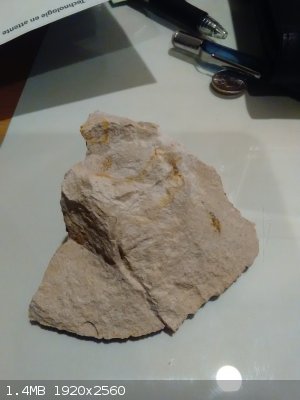
It looks more white in person than it does in the picture.
|
|
|
diddi
National Hazard
   
Posts: 723
Registered: 23-9-2014
Location: Victoria, Australia
Member Is Offline
Mood: Fluorescent
|
|
quartz or mica? the facets look quite flat on the sparkly bits.
Beginning construction of periodic table display
|
|
|
aga
Forum Drunkard
    
Posts: 7030
Registered: 25-3-2014
Member Is Offline
|
|
Quote: Originally posted by blogfast25  | I would take a small amount (a few g) of B and of C. Then treat those samples with HCl and observe (dissolves? Gas?)
Then filter and carefully neutralise until precipitates appear.
Then filter off and wash precipitates and test these with NH3 and NaOH. |
If you would, then it is likely worth copying, so i did.
All prepared as suggested (minus the careful bit) and are drying overnight.
Samples D and E were taken from the same spot, and are behaving the same, so likely the same material.
Eliminating E leaves samples B, C and D
B happily dissolves like crazy in HCl.
C just makes the water brown - no bubbles evolved at all
D Also goes like crazy in HCl, evolving CO2 gas.
(if you smoke, just get the fag going and stick it in the beaker : the redness on the end immediately disappears)
D in 96w% sulphuric acid goes slowly, unless you heat it, in which case it evolves gas like crazy.
Each dissolved sample was filtered, and the resulting acidic liquor neutralised with a 6 [M] NaOH solution.
In all cases the point of neutrality was missed, despite using a 3ml dropper pipette, NaOH added drop by drop, and the resulting liquors all tested to
be > pH 8.
Sample B in HCl gave a grainy white precipitate which rapidly settled to the bottom of the beaker.
Sample C in HCl gave a Brown flocculous precipitate.
Watching it form, it's like a series of tiny brown avalanches running down a brown mountain.
Sample D in HCl gave a creamy white precipitate.
Sample D in sulphuric acid was odd.
A White flocculating precipitate formed during heating with H2SO4 (before the acid was neutralised).
This was filtered out (is drying) and kept for later testing.
All of the HCl stuff in the filter papers was washed once with distilled water.
The liquid leaving the filter (filtrant ?) was Clear like water in each case.
Tomorrow some dissolving in NH3 and NaOH.
All and Any pointers on best (most useful) procedure most welcome.
[Edited on 2-8-2015 by aga]
|
|
|
blogfast25
International Hazard
    
Posts: 10562
Registered: 3-2-2008
Location: Neverland
Member Is Offline
Mood: No Mood
|
|
My money is on B and D being mainly limestone. C 'sounds' the most interesting of the three.
|
|
|
The Volatile Chemist
International Hazard
    
Posts: 1981
Registered: 22-3-2014
Location: 'Stil' in the lab...
Member Is Offline
Mood: Copious
|
|
Indeed, do you have pictures of the original rocks un-digested?
Nice spreadsheet diddi!
I'm going a'rock hunting this week, and will show some pics when I'm back from vacation.
|
|
|
diddi
National Hazard
   
Posts: 723
Registered: 23-9-2014
Location: Victoria, Australia
Member Is Offline
Mood: Fluorescent
|
|
thx. 
Beginning construction of periodic table display
|
|
|
aga
Forum Drunkard
    
Posts: 7030
Registered: 25-3-2014
Member Is Offline
|
|
The filtered material was dry today, apart from D which is more like a toothpaste consistency.
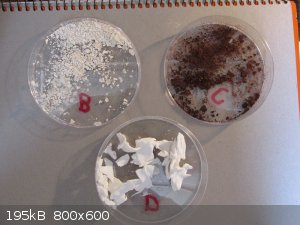
A small quantity of each was added to 2 test tubes, placed in a rack side by so that tubes 1 & 2 held sample B, 3 & 4 sample C, 5 & 6
sample D. Tube #1 is on the left.
~0.5ml of water added to all tubes. Unsurprisingly none dissolved in water.
6 [M] NaOH solution was added to tubes 1, 3 and 5 in 1ml portions with vigorous shaking between additions.
33w% NH3 solution was added to tubes 2, 4 and 6 in the same manner.
Here are the results :-
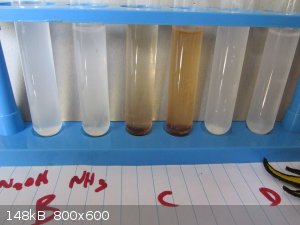
It appears that C does not dissolve significantly in either.
B and D appear to slightly dissolve in both NaOH and NH3, so would it be said that they Do dissolve or Do Not dissolve ?
|
|
|
blogfast25
International Hazard
    
Posts: 10562
Registered: 3-2-2008
Location: Neverland
Member Is Offline
Mood: No Mood
|
|
Quote: Originally posted by aga  |
B and D appear to slightly dissolve in both NaOH and NH3, so would it be said that they Do dissolve or Do Not dissolve ?
|
Considering some of it clearly hasn't dissolved, I would say these precipitates are insoluble (in NaOH and NH3(aq)). That points to Ca(OH)2 or
Mg(OH)2.
If you redissolve them in a small amount of HCl, then add some H2SO4, in the case of Ca you should get poorly soluble CaSO4.
[Edited on 3-8-2015 by blogfast25]
|
|
|
aga
Forum Drunkard
    
Posts: 7030
Registered: 25-3-2014
Member Is Offline
|
|
CaSO4 it is then !
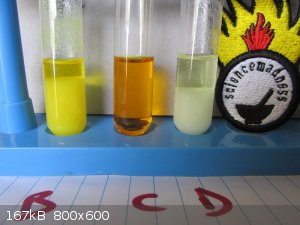
|
|
|
blogfast25
International Hazard
    
Posts: 10562
Registered: 3-2-2008
Location: Neverland
Member Is Offline
Mood: No Mood
|
|
So what you've got with B and D is (probably) mostly limestone, which is common as muck.
C is therefore your most interesting rock so far. Can you put up a photo of C?
[Edited on 3-8-2015 by blogfast25]
|
|
|
aga
Forum Drunkard
    
Posts: 7030
Registered: 25-3-2014
Member Is Offline
|
|
B, C and D in the nude :
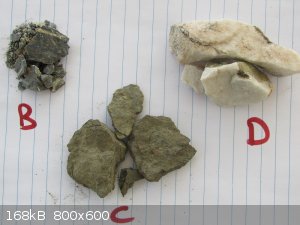
Close-up of C (which is basically the earth around here) :
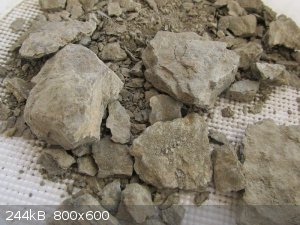
[Edited on 3-8-2015 by aga]
|
|
|
aga
Forum Drunkard
    
Posts: 7030
Registered: 25-3-2014
Member Is Offline
|
|
The C sample after dissolution in HCl seems to have some Sulphur deposited on it, as there is a dusting of Sulphur Yellow on it, collected in nooks
and crannies.
Might zap it with Cl2 and see if it dissolves away.
Is there a simpler (less toxic) test for sulphur ?
[Edited on 3-8-2015 by aga]
|
|
|
blogfast25
International Hazard
    
Posts: 10562
Registered: 3-2-2008
Location: Neverland
Member Is Offline
Mood: No Mood
|
|
C also yielded bubbles on dissolution in HCl, correct?
Try heating a sample in a Bunsen or such like: the smell of SO<sub>2</sub> is quite distinctive (think yellow matches!) Taking chlorine to
it seems overkill. I think your powder is a bit of gangue material.
|
|
|
aga
Forum Drunkard
    
Posts: 7030
Registered: 25-3-2014
Member Is Offline
|
|
Actually (now that i have the notes on hand) sample C did Not evolve bubbles when HCl was added.
There were a very few (30 or so) bubbles when the HCl was added, which could easily have been air escaping.
My earlier statement was wrong.
Distrusting even my own scribblings i tried it again just now with NaOH, HCl, H2SO4 and HNO3.
Sample C give no bubbles, or even any visible reaction, apart from the HCl solution going pale green.
The Yellow stuff may well be gangue/SOS as there was no SO2 smell when the rock was burnt.
[Edited on 3-8-2015 by aga]
[Edited on 3-8-2015 by aga]
|
|
|
blogfast25
International Hazard
    
Posts: 10562
Registered: 3-2-2008
Location: Neverland
Member Is Offline
Mood: No Mood
|
|
Well, at least C appears more interesting than ordinary carbonaceous crap! 
|
|
|
Texium
Administrator
       
Posts: 4581
Registered: 11-1-2014
Location: Salt Lake City
Member Is Offline
Mood: PhD candidate!
|
|
I wish that I had more than just ordinary carbonaceous crap here. 
Just west of where I live everything is made of granite, the pinkish kind that they used for building the Texas State Capitol. That stuff would be even less fun to play with though, being as it's primarily silicates and alumina and will likely yield to
nothing. At least limestone can be dissolved.
[Edited on 8-4-2015 by zts16]
|
|
|
blogfast25
International Hazard
    
Posts: 10562
Registered: 3-2-2008
Location: Neverland
Member Is Offline
Mood: No Mood
|
|
Sure. And you get CaCl<sub>2</sub>. Exciting! (NOT!) 
Not meaning to rain on anyone's parade but so far I haven't seen much 'rock molesting' here... 
[Edited on 4-8-2015 by blogfast25]
|
|
|
| Pages:
1
2
3
4
5 |